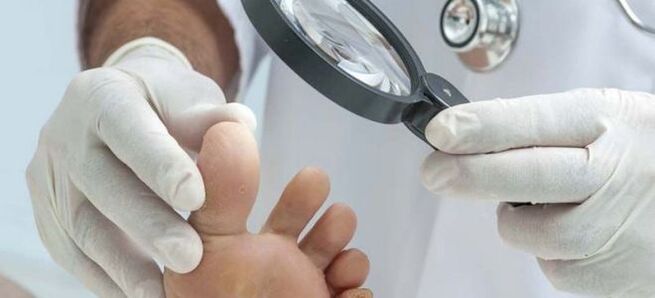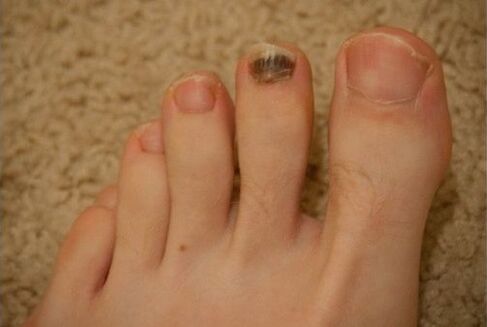Fungal disease of the toenails - onychomycosis - is caused by dermatophytes and microspores.A 2003 study of leg disorders found leg disorders to be the most common in 16 European countries.
The fungus can affect the free edge of the nail, the sides, the back fold, and the entire nail plate.Depending on the severity of the disease, onychomycosis can be divided into:
- Normal nutrition;
- Hypertrophy;
- shriveled.
Changes in nail color and structure can range from minor to major to complete destruction.
The pharmaceutical industry produces effective treatments for toenail fungus.These are tablets, varnishes, sprays, ointments and solutions.In addition, we also use traditional medicine formulas and have accumulated rich experience in treating fungal diseases.

Although there are a variety of medications and home remedies, there is nothing you can do to start treating it on your own.After diagnosis, a consultation with a mycologist or dermatologist will recommend the best way to treat onychomycosis.In approximately 50% of cases, patients develop nonfungal deformations of the nail plate.
What you need to know before starting fungal treatment
The main route of transmission of infection is contact.Fungal spores thrive in warm, moist environments.Therefore, you may get an onychomycosis infection:
- By the patient’s personal belongings—shoes, towels, socks;
- In baths, saunas, swimming pools, beaches – anywhere people go barefoot;
- A pedicure room that does not meet sanitary requirements.
The direct penetration of infection into human cells is caused by a decrease in local and systemic immunity.These are:
- Chronic diseases - diabetes, blood diseases, gastrointestinal diseases;
- Nail injuries, foot abrasions;
- previous viral illness;
- Taking antibiotics, corticosteroids, immunosuppressive drugs;
- HIV, immunodeficiency.
Fungal infections break through the "open door" and begin active life.Aggravation of disease course:
- Hyperhidrosis of the feet - increased sweating;
- Often wear tight shoes made of low-quality materials;
- Lack of personal hygiene.
Before starting treatment and choosing a treatment for onychomycosis, you need to analyze the cause of the disease.Combining treatments and eliminating the factors that trigger onychomycosis can really help.The disease is known for frequent recurrences.
Examination before starting treatment for toenail fungus
At the appointment, the dermatologist will examine the infected area to determine changes in nail color and structure and the nature of the lesion.He used special instruments to scrape tissue samples for analysis.
Determine the type of pathogen by microscopic examination or inoculation in nutrient media.The samples are treated with special compounds and examined under a microscope.Analysis times range from 15 minutes to a day.When sowing seeds, a piece of infected tissue is placed under favorable conditions to germinate for 25-30 days.
The external manifestations of onychomycosis are similar to those of other diseases: psoriasis, keratosis, onychodystrophy, and lichen planus.Laboratory diagnosis confirms:
- presence of fungi;
- its type;
- Quantitative characteristics of infection;
- Sensitivity to drugs.
Urine and blood tests are performed to determine the stage of the disease, infection of internal organs, and possible side effects of medications.After treatment, the test is repeated.

PCR (polymerase chain reaction) tests have shown high accuracy in identifying pathogens.Such studies can determine the type of fungus in the case of mild external manifestations of the disease, help to select effective and effective drugs and speed up recovery.
Treatment preparation procedures
For the benefits and maximum results of the treatment, you need to prepare your nails for the medication.To do this, the affected area of the nail plate needs to be cleaned and removed mechanically or with the use of a keratolytic cream.
Machining is performed with pliers or files.These patches soften the affected nail area painlessly and non-invasively.Afterwards, remove them with scissors or a dull scalpel.
Bifonazole is used as a keratolytic agent to remove affected nails.Apply the ointment included in the kit to the nail plate and cover it with a bandage or adhesive plaster.After a day, clean the softened area and repeat the process until the affected area is completely removed.Topical antifungal therapy was initiated simultaneously.
important.Good nail plate preparation allows the medication to quickly penetrate deep into the nail and destroy the fungal mycelium.
Medical drugs and treatments
All medications used systemically to treat fungal nail disease should be taken exactly as prescribed by your doctor and as directed.Antifungals often have side effects, age restrictions, and contraindications.They must be taken into account.
Modern medications for treating toenail fungus come in the form of tablets, ointments, varnishes, gels, solutions and sprays.The most effective results are achieved using a combination of oral and topical medications.
The following effective medications have been used successfully:
Tablet drugs - terbinafine, fluconazole, itraconazole, griseofulvin, ketoconazole.The active ingredient is highly active against pathogenic fungi.The recommended dosage is stated in the drug package insert.The duration of treatment depends on the severity of the disease and usually ranges from 1.5 to 18 months.It's effective using pulse therapy - high doses of medication taken in short bursts separated by three weeks.

Ointments, creams - naftifine hydrochloride, terbinafine, clotrimazole.The active ingredients in the preparation have fungistatic and fungicidal properties, that is, they prevent the growth and reproduction of fungi and destroy the mycelium.Apply product to clean and dry nail plates 2-3 times daily.Good results can be obtained in combination with medications in tablets.
Gels, solutions, serums - terbinafine, etc.Antifungal ingredients accumulate in keratinocytes and kill fungi and their spores.
antifungal nail polish
One of the best ways to treat toenail fungus is an antifungal varnish.It covers the surface with an airtight film that prevents oxygen from entering the affected area.
The active ingredients of the drug penetrate deep into the tissues, accumulate and destroy pathogens.The coating is durable and won't sag.Some varnishes can be used under trim.This is an added advantage if the treatment is performed during the summer.
Varnishes have a good therapeutic effect; they contain active ingredients - terbinafine, amorolfine, ciclopirox.Apply to clean, dry nails 1-2 times per week for 1 to 12 months.They have contraindications.
Home remedies for fungus
Home remedies can be helpful in cleaning and disinfecting nails with onychomycosis.With regular use, fungal threads and spores are destroyed.
Effective results can be achieved by combining traditional recipes with medicinal treatments.
Vinegar is one of the dangerous remedies for treating onychomycosis.Available in glycerin-based baths, liniments and ointments.
Regular wiping with iodine and celandine juice can kill the pathogens of onychomycosis.
They are anti-inflammatory and contain baking soda, tea tree oil, or lavender, which are very soothing.
A compress made from onion or garlic pulp and vegetable oil works well against fungal nail infections.
Birch tar is a distilled product of birch tree resin and is known for its powerful antifungal effects.
important.Folk remedies for onychomycosis may have contraindications.You should consult your doctor before using them.
How to avoid needing treatment
To avoid getting a fungal infection and needing treatment, you need to take the following precautions:
- Avoid touching other people’s personal belongings;
- Wear shoes in bathrooms, saunas, showers and on the beach;
- Strengthen the immune system and develop a healthy lifestyle;
- Will not suffer from chronic diseases;
- Choose high-quality, comfortable shoes.
If you notice symptoms of onychomycosis, do not self-medicate.It is necessary to visit a doctor, get examined and receive treatment with effective treatments for onychomycosis.
















